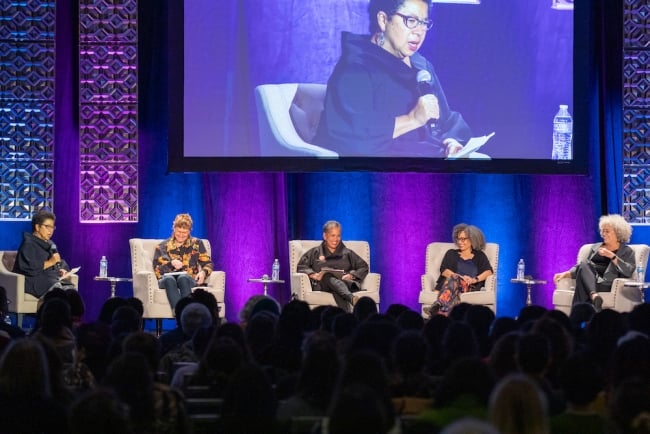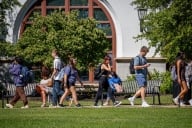You have /5 articles left.
Sign up for a free account or log in.

A panel from the 2022 conference of the National Women’s Studies Association. The organization found that about half of all women and gender studies departments had seen enrollments increase.
NWSA
Professors of women and gender studies nationwide say that students’ interest in the field is blossoming, even as their work is being impacted by right-wing criticism, according to a new report by the National Women’s Studies Association (NWSA).
The report, entitled “Protecting Our Futures: Challenges & Strategies for Women’s, Gender, and Sexuality Studies,” uses data gathered from 244 women and gender studies departments across the country in early 2023. It is the first survey the association has ever conducted of its member departments, according to report co-author Angela Clark-Taylor, executive director of the Flora Stone Mather Center for Women and a research assistant professor at Case Western Reserve University.
The research was prompted in large part by attacks against the women and gender studies discipline, as well as against diversity, equity and inclusion more broadly. Numerous states, including Wyoming and Florida, have introduced legislation to defund or ban such programs; at New College of Florida, DeSantis-appointed trustee Christopher Rufo successfully introduced a motion to remove the women and gender studies department.
But despite attacks on the field, which critics have called “an ideology not a science,” students are apparently taking an increased interest in it. Undergraduate enrollment in women and gender studies classes has increased in about half of all departments, the report shows, remained the same in about 30 percent and declined in 20 percent. Just under half of respondents said the number of students pursuing a women’s studies minor has increased. Growth for women’s studies as a major is more tenuous; 36 percent of respondents said the number of majors in their department has increased, only slightly more than the 32 percent who cited a decrease.
According to the report, national political events, including the repeal of Roe v. Wade, have played a role in increasing student interest in women and gender studies.
Ariella Rotramel, another of the report’s authors and the chair of the Department of Gender, Sexuality and Intersectionality Studies at Connecticut College, who uses they/them pronouns, observed that despite the political backlash, the stigma that used to exist around the relatively new field—the first women’s studies program was created in 1970—has largely dissipated.
“I definitely remember tabling academic fairs, and nobody [wanted] to make eye contact and students [weren’t] going to bring their parents to talk to me,” they said. “Now, I have people coming into undergrad who want to do gender studies. They actually know it exists.”
Professors Feel the Heat
The heightened political climate that has increased student interest in feminism and women’s studies has also elicited a wave of animosity for the field and for DEI more broadly. Respondents across the country say these attacks have impacted their work, even in states where women’s studies isn’t specifically being targeted.
“Overall they have not been able to limit our teaching of Gender Studies courses,” one professor in Texas said in the survey. Even so, “I feel scared … to speak about abortion rights in any classes of mine. I would likely get in trouble for doing so—students are making reports about any inclusion or diversity language that professors are using—they are reporting directly to the upper administration, and we are getting pushback. We feel watched and monitored.”
Even faculty working in states with no anti-DEI bills said they were worried about traveling to other states for conferences or receiving backlash from conservative media or lawmakers for teaching controversial subjects, Clark-Taylor said.
“There was no one who was just like, ‘Everything is good,’” she said. “Everybody felt some level of pressure around anti-DEI legislature.”
Rotramel concurred. Although their department is relatively well-positioned and resourced, they worry about how attacks on women and gender studies in other states could affect their work and students in the future.
“The questions really are about, ‘OK, what will this look like in five, ten years, in terms of the national picture? Is this going to impact funding? Could there be things at the federal level that change how higher education works?’” Rotramel said. “How does this work for my students in terms of their future educational and career opportunities if there is backlash to their credentials?”
Despite increased student interest, many respondents said their departments are under-resourced. About 40 percent said their budgets have decreased recently, while only 12.1 percent reported increases; about a quarter have lost staff, and just over a fifth have seen a decrease in full-time faculty (though many departments have no full-time faculty members at all).
Departments were significantly more likely to report budget increases if the respondent perceived their institution’s president, provost and dean as being supportive of the department. Overall, 79 percent of respondents said their deans were supportive, but only about half felt the same about their provosts (53 percent) and presidents (49 percent).
The report noted that some respondents were encouraged by their institutions appointing more women in leadership roles—but added that such appointments didn’t always lead to increased support for women and gender studies programs.
“The current/new [president] talks the talk of women’s equality, but it is not a really modern version (more of a 90s/Lean In type of ‘feminism’ with the focus on leadership/power positions rather than equity & justice). She also does not support LGBTQ issues/community members,” wrote one respondent.
Looking Ahead
The association plans to do further research building on the “Protecting Our Futures” report, potentially looking at populations it doesn’t examine, including those in programs at two-year institutions. Clark-Taylor said she would be interested in analyzing whether the identities of department chairs impact how their departments are perceived and what resources they receive.
“Are Black women treated the same way as department leaders as white women? [The survey yielded] some small comments about these things that made us wish we asked some deeper questions, but we’re hoping this is the first of many studies that … the national organization takes on in the future and does on a fairly regular basis,” she said.
Clark-Taylor said she hopes that the report reaches upper university administrators and helps them understand the value that women and gender studies adds to their institution.
But the association’s leaders also hope that it will reach readers beyond the traditional stakeholders—and even outside of academe.
“I’d love for organizers, artists, curious people to engage in this initial dataset, because our hope, through the association, is that we continuously expand and make space to honor but also amplify and invite the other ways that feminist work and education and innovation lives and breathes,” said Kristian Contreras, interim executive director of NWSA. “And that might not be on a higher education campus.”








